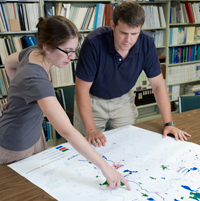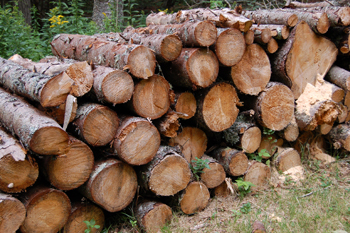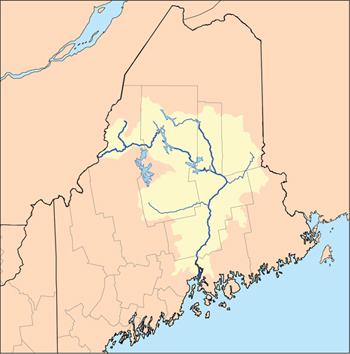Mapping a Sustainable Future
 Analysis of Alternative Futures in the Maine Landscape using Spatial Models of Coupled Social and Ecological Systems
Analysis of Alternative Futures in the Maine Landscape using Spatial Models of Coupled Social and Ecological Systems
- The Maine Futures Community Mapper
Link to mapping tool developed under this project - New England Landscape Futures
Link to research led by Harvard Forest influenced by this project
Institutions: University of Maine, University of Maine School of Law
Sponsors: National Science Foundation through the Sustainability Solutions Initiative, Elmina B. Sewall Foundation
Major forces are altering Maine’s communities and landscape. Over the past 15 years, development pressure has intensified in the southern part of the state, and millions of acres of forest have changed hands in the north. Rob Lilieholm, UMaine associate professor of forest policy, is leading a research team developing new forecasting tools to help communities better plan for their future in the face of sweeping change.
Why This Project?
 Inefficient development patterns can increase taxes and infrastructure costs and undermine quality of life and ecosystems. In northern Maine, ownership changes in large tracts of forest in which land is divided into smaller parcels among more owners can lead to fragmentation. As the landscape becomes fragmented, it often becomes less open to traditional uses such as recreation and timber harvesting, and more vulnerable to development.
Inefficient development patterns can increase taxes and infrastructure costs and undermine quality of life and ecosystems. In northern Maine, ownership changes in large tracts of forest in which land is divided into smaller parcels among more owners can lead to fragmentation. As the landscape becomes fragmented, it often becomes less open to traditional uses such as recreation and timber harvesting, and more vulnerable to development.
Planners and other decision-makers have only limited information to navigate such complex challenges, yet the choices they make today will affect the economic, social and environmental future of their communities.
Connecting Knowledge with Action
Lilieholm and his colleagues are using a technique called alternative futures modeling to simulate how different land use policies, changing demographics and other key variables could affect the Maine landscape. These models synthesize complex data from many sources to generate computerized maps that will help users identify suitable lands for various purposes such as development, conservation, and protection of working forests and farmland.
Planners, landowners, citizen groups and others can use these maps to simulate future scenarios and evaluate trade-offs and consequences, economic and otherwise, of alternative land uses. Such information will contribute to more efficient and sustainable development patterns and improve strategic conservation of land important for purposes such as food and timber production, wetlands protection, wildlife habitat and recreation.
The Maine Futures Community Mapper
 New! Maine Futures Community Mapper Video Series
New! Maine Futures Community Mapper Video Series
Researchers, led by SSI graduate student Spencer Meyer, recently convened a group of Maine leaders in economic development, conservation, forestry, and agriculture to identify strategic land use opportunities and potential conflicts. This project proposes to build a web-based planning tool based on this research so communities and land trusts can better balance conservation with economic development.
During recent land use research in the Lower Penobscot River Watershed (LPRW), it became apparent that communities and land trusts typically do not have access to the diverse types of information required to balance the objectives of both conservation and economic development during their planning. Our tool is novel because it combines social, environmental, and economic information into one planning tool. Key stakeholders have expressed a strong demand for this kind of information, so we propose to develop the Maine Futures Community Mapper (MFCM) to provide this information freely.
The open-access website will allow communities and land trusts to identify areas that are well-suited for development but do not impact regionally significant conservation or natural resource assets. Initially, the MFCM will include maps for the LPRW and will expand as our ongoing research produces additional maps, such as for the Casco Bay and Androscoggin watersheds, where we recently expanded our work. Building on the stated need for such a tool, we will first hold a series of focus groups to ensure the MFCM includes the most relevant features for users. After the tool is developed we will conduct training workshops tailored towards online use and integration with stakeholders’ off-line datasets. Finally, we will provide a “how-to” training video on MFCM.
By providing users with maps of high-value conservation, economic, and natural resource assets and the potential opportunities and conflicts among these, stakeholders will be able to make more informed land use decisions regarding land use priorities within their communities and regional partnerships.
Maine Futures Community Mapper Video Series
- Introduction
- Part 1 Console
- Part 2 Identifying Priorities
- Part 3 Opportunities/Conflicts
- Part 4 Future Scenarios
Team members:
Rob Lilieholm, Forest Resources (team leader)
Chris Cronan, Biology & Ecology
Dave Owen, University of Maine School of Law
Graduate Students
Spencer Meyer (Forest Resources), Project Leader, Maine Futures Community Mapper
Michelle Johnson (Forest Resources)
Thomas Parr (Ecology and Environmental Science)
Additional Resources
- To use the Maine Futures Community Mapper, visit www.MaineLandUseFutures.org
- Sustainable Maine Season 3 – Preserving Paradise
- Solutions article: Mapping Maine’s Future (Sept 2011)
- News – SSI Team Develops Online Tool that Maps Future Landscapes
- News – Online Mapping Tool Featured by Forests for Maine’s Future
Supported by National Science Foundation award EPS-0904155 to Maine EPSCoR at the University of Maine.
